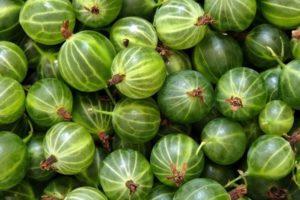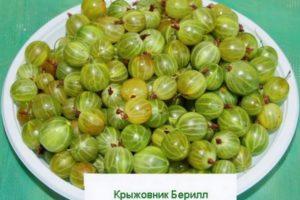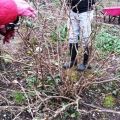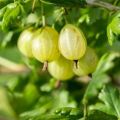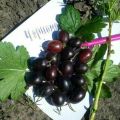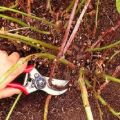When and how to properly prune gooseberries for a good harvest
Already at planting, a gooseberry seedling needs pruning. There are rules for when and how to do it correctly. Berry bushes waste space in the garden if they do not form their crown annually. The yield of such bushes is low, the berries are small. To get a good harvest, watering and feeding gooseberries alone is not enough.
Why do gooseberries need pruning
Gooseberry bushes consist of branches of different ages. Zero-order branches are young basal shoots. A year later, lateral ramifications form on them - shoots of the 1st order. On the branch of the gooseberry, from 5 to 6 branches are formed.
The shortest are fruits, they are formed on 2-year-old wood. Flower buds and berries are formed on them. The age of the branch can be determined by the knees on the pillow. The fruit is functioning for 5-6 years. The maximum fruiting occurs at the age of 2-3 years.
In the crown of the bush, there must be branches of the 1st, 2nd, 3rd order. The maximum number of berries is formed on them. The transition of the escape from one order to another takes 1 season. During the growing season, the branches grow by 8-30 cm.
A gooseberry branch can bear fruit for up to 10 years, but the maximum return is in 5-year-olds. Old branches fall apart on the sides, sink to the ground. Bushes, especially those with thorns, are overgrown. Care is getting harder. Productivity decreases if you do not control the condition of the crown: the age of the branches, their number.
To maintain abundant fruiting throughout life, gooseberries are subjected to different types of pruning:
- anti-aging;
- formative;
- sanitary.
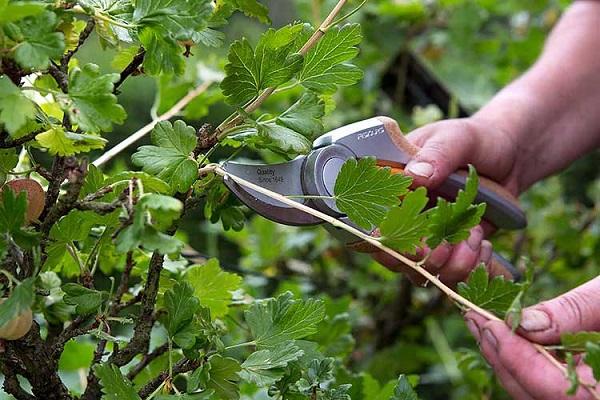
Briefly, you can outline the goals that are pursued by pruning gooseberries:
- to discharge the crown of the bush, to balance the aboveground and underground parts of the bush for an even distribution of nutrients and light - the task of formative pruning;
- removing old weakly fruiting branches, stimulating new growth - the task of rejuvenating pruning;
- cutting out sick and damaged shoots, preventing fungal diseases (powdery mildew) is the task of sanitary pruning.
The first time a bush is formed when transplanting a seedling. Early pruning lays the foundation for the future crown of the shrub.
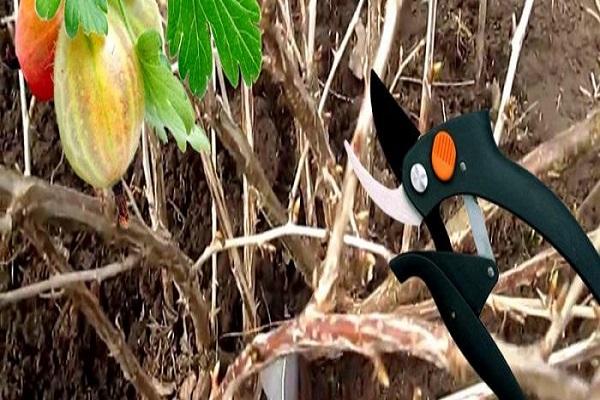
Necessary garden tools for work
Thornless gooseberry bushes are easier to care for than thorny ones.For gardening work, you need to purchase special gloves for your hands that protect against thorns and sharp branches. From the tools you need to have:
- secateurs for shoots up to 10 mm in diameter;
- lopper for thick branches from 20 to 50 mm;
- a garden hacksaw for cutting out old, thick branches.
In what time frame to carry out the procedure
Large-scale works are recommended to be planned for the fall. This time of the year is most favorable for crown formation.
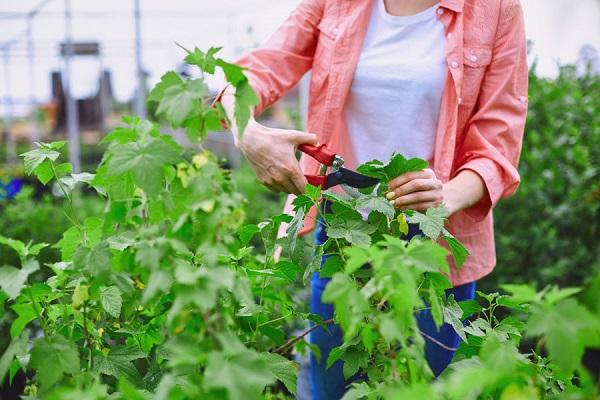
Spring bush formation
You need to be in time before bud break. After the leaves appear, the branches should not be cut. There is little work in the spring if the bush was well prepared for winter. Immediately after the snow melts, you need to do 3 types of operations in stages:
- cut out all frozen branches;
- shorten the weakened branches by a third of the length;
- strong, but mechanically damaged shoots, cut, leaving a healthy area.
Pruning in the summer months
Summer works are carried out with one goal - to improve the quality of berries (taste, size). With the help of pruning, the maximum amount of nutrients is directed to fruiting:
- young shoots (zero) of this year, growing from the root, are completely cut out;
- shorten non-fruiting branches, leaving at least 7-8 leaves on each.
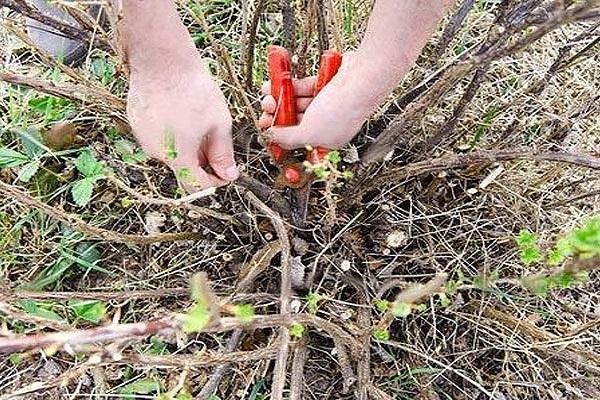
How to cut gooseberries in the fall: scheme
Begin by examining the bush. The first step is to remove branches damaged by disease, bad weather, insects. The next step is to cut branches 5 years old and older. If all branches are old, remove no more than ⅓ from the whole number.
The third in turn are the branches lying on the ground. They have poor fruiting, they get sick more often. All unripe shoots are removed in autumn. Additionally, thinned crowns are thinned out. Cut out all unnecessary branches that interfere with normal lighting, airing the central part of the bush.
Should you prune in winter?
There are no planned winter works with the crown, only emergency ones. Large branches can break off under a thick layer of snow or due to heavy icing. In this case, no spring is expected. The timing is adjusted, sanitary pruning is carried out in winter. They do it if the average daily temperature does not drop below -5 ° C.

Principles of formative pruning depending on the age of the shrub
A gooseberry seedling is formed before planting in a pit. Weak, thin shoots are cut in the area of the root collar. The remaining branches are shortened. Those that are more powerful are above the 3-4th kidney, those that are thinner are above the 2nd. The kidneys are counted from below.
In the 2nd year, the seedling has at least 3 biennial branches and several annuals. You need to select 7 vertical, growing from the root collar, strong branches, shorten them to a height of 30 cm. Horizontal shoots and root shoots must be cut at the base. Shorten the remaining ones to 20 cm.
By the fall of the 3rd year of life, the gooseberry bush grows. He needs to leave 12-18 branches of different ages. They will be the basis of the crown of a fruiting bush. This year the gardener must:
- cut horizontally growing shoots and all weak ones;
- shorten all remaining branches by 12-15 cm.
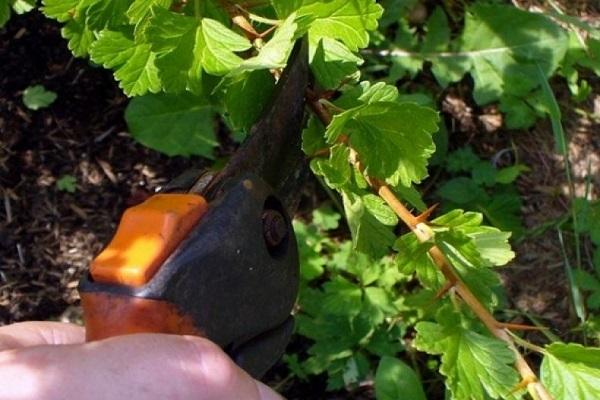
Starting from the 4th year, the planned work will be the same. Bushes 4-year-old are considered adults, they are already bearing fruit. The crown should have 15-20 branches of different ages. All 5 year old branches should be cut annually. For replacement, leave 3-5 pieces of the strongest of the young growth.
The specifics of various types of pruning
Young fruiting bushes are subjected to formative and sanitary pruning during the season. Old bushes, on which there are few berries, are subject to rejuvenation. When forming the crown, they are guided by the age of the shrub, the number of branches of different ages, the degree of their illumination. When carrying out sanitary cleaning of the crown, the health of the shoots is assessed:
- the presence of mechanical damage;
- frostbite;
- the presence of foci of infection and insects.
How to prune old, neglected gooseberries
You can fully restore the fruiting of a neglected gooseberry in 2-4 years.The first step is to thin out the bush. Branches fall under the full cut:
- growing horizontally;
- old, they can be identified by the dark, almost black color of the bark;
- broken and bent.
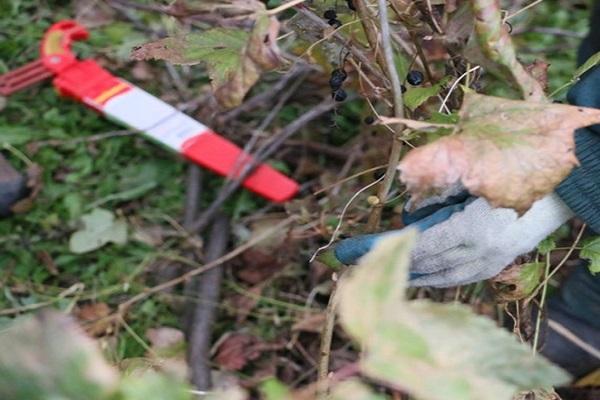
Vertically growing branches should be inspected. Leave 5 pieces. They cut off the tops. Cut over the first lateral, strong branch. In subsequent years, it is necessary to deal with the formation of the crown in the system, to prevent its thickening.
Pruning gooseberries after harvest
In August, when the berry collection is over, the condition of the bush is assessed. In summer, after harvesting, gooseberry sanitary pruning is rarely carried out. It is advisable to carry out it if there are symptoms of a fungal disease or insects on the leaves, shoots.
Remove all diseased branches. The bush is treated with a fungicide. The land around the gooseberry is cleared of debris, loosened, and covered with mulch. Removal of diseased branches should be postponed for a month if signs of the disease appeared in July.
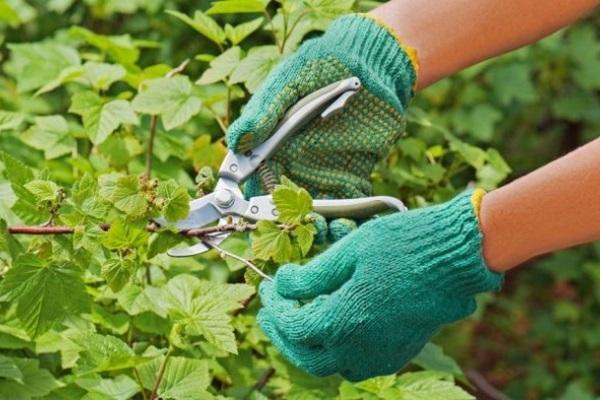
Gooseberry rejuvenation technique
Bushes at the age of 5 years or more require rejuvenation. It is not carried out at random. First, the number of branches, their age and the level of fruiting are estimated. The first to be removed are 3-5-year-old branches, on which there were the fewest berries. They are recommended to be cut at the base, without leaving hemp.
Next, cut out all unpromising, thin, weakened branches. Of the new growth, 5 of the strongest vertical shoots are left. They will be the new base of the bush. All other branches are shortened, only the tops are trimmed. This stimulates branching.
Non-standard methods of forming a bush
The original options for crown formation attract experienced gardeners who grow vigorous gooseberry varieties, those who like to decorate the garden with shrubs of an unusual shape.

Shpalerny
This method is suitable for vigorous shrub varieties. A trellis should be made along the shrub plantings. The simplest design consists of 2 pillars and 3 rows of wire stretched between them in 25 cm increments.
Gooseberry seedlings, when grown on a trellis, must be planted according to a certain scheme:
- row spacing - 1.5 m;
- the interval between bushes growing in the same row is 0.7 m.
On each bush, you need to leave 4-5 pieces of branches of a new growth, tie them to a wire stretched between the posts. Cut out newly appearing young shoots. Shorten last year's branches by ⅓ length.
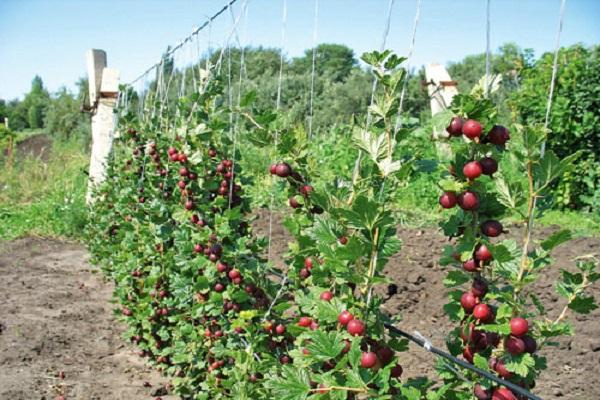
Stamp
Gardeners get the original gooseberry tree by shaping the crown in a special way. At the same time, they want more to get a decorative, rather than abundantly fruiting element of the garden. You need to start work in the 1st year after planting the seedling.
Leave only 1 of the most powerful shoot, remove the rest at the very base. In the 2nd year, cut off all side branches. The height (recommended) of the obtained stem is 50-70 cm. This section of the stem can be wrapped with a soft cloth so that dormant buds do not wake up. Starting from the 3rd year, form the crown of the tree, cut out all the shoots that appear in the area from 0 to 100 cm.
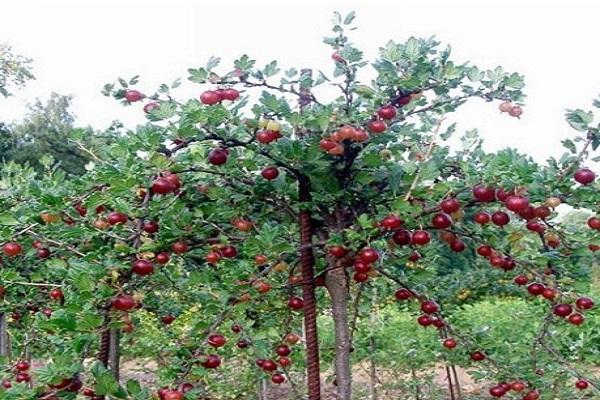
Care after pruning
Every gardener should have a garden pitch at hand. In spring and autumn, its presence is required. It was at this time that the shrubs are cut dramatically. Thin shoots are not treated with it. Their slices dry out quickly. Wounds with a diameter of 2-5 cm are covered with vario.
Garden var is a viscous substance, it creates a strong film that does not allow infection and harmful insects to pass through. Some gardeners make their own garden pitch. It is believed that the composition of store products includes harmful components. Used in home production:
- resin;
- turpentine;
- rosin;
- beeswax.
After pruning, gooseberries are fed, watered, and the trunk circle is mulched.
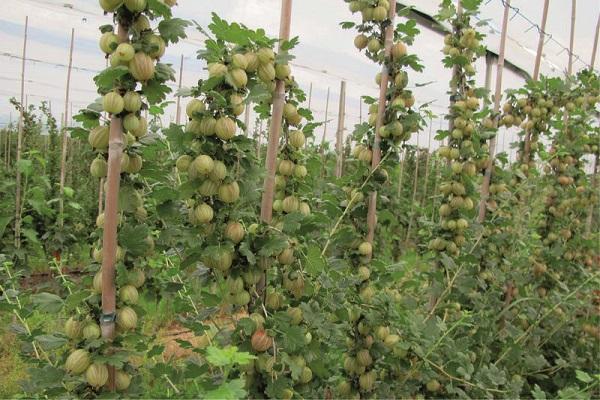
Frequent mistakes of novice gardeners
The mistakes of novice gardeners are of the same type. Many pass through them. Here is a list of the most traditional ones:
- When carrying out anti-aging pruning, cutting out branches of a large diameter, leave hemp. Pests settle in them, they become a constant source of infection.
- They are afraid to cut out many branches, although this is necessary to form the correct crown. The aboveground part of the gooseberry is quickly restored, so unnecessary branches should be cut out. The bush will recover from the buds that are underground.
- A bush is formed without analyzing the age of the shoots. They direct their efforts to the decorative component.
- Sections are made randomly, they forget that the line must pass over the kidney.
- Use a blunt garden tool, do not disinfect the cutting blades before work. They spread the infection around the garden.
Before carrying out work, it is worth refreshing your knowledge, remembering the features of the gooseberry. Each bush that has received the necessary care will certainly thank you with a harvest, if not this year, then the next.
